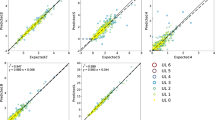Abstract
A review is presented of the relationships between aqueous solubility, melting point, vapour pressure, boiling point, Henry’s Law constant, sorption partition coefficient, bioconcentration factor, octanol/water partition coefficient, and molecular structure. It is suggested that progress towards establishing quantitative structureactivity relationships can best be made by considering four categories of properties and their linking equations, namely molecular descriptors, fundamental thermodynamic functions, physical-chemical properties, and environmental partitioning quantities.
Access this chapter
Tax calculation will be finalised at checkout
Purchases are for personal use only
Preview
Unable to display preview. Download preview PDF.
Similar content being viewed by others
References
Bobra, A.M, Shiu, W.Y. and Mackay, D. 1983. Toxicity of hydrocarbons and crude oils. Proceedings of the 6th Arctic Marine Oil Spill Program Technical SeminarEdmonton, Alberta, pp. 52–58.
Chiou, C.T., Freed, V.H. Schmedding, D.W. and Kohnert, R.L. 1977. Partition coefficient and bioaccumualtion of selected organic chemicals. Environ. Sci. Technol.11: 475–478.
Chiou, C.T. Schmedding, D.W. and Manes, M. 1982. Partitioning of organic compounds in octanol/water systems.Environ. Sci. Technol. 16:4–10
Dickson, K.L., Maki, A.W. and Cairns, J., Eds. 1982.Modelling the fate of chemicals in the aquatic environment.Ann Arbor Science, Ann Arbor, Michigan.
Karickhoff, S.W., Brown, D.S, and Scott, T.A. 1979. Sorption of hydrophobic pollutants on natural sediments. Water Res.13: 241–248.
Mackay, D. and Shiu, W.Y. 1977. Aqueous solubility of polynuclear aromatic hydrocarbons. J. Chem. Eng. Data 22:399–402.
Mackay, D. 1979. Finding fugacity feasible. Environ. Sci. Technol. 13:1219–1223.
Mackay, D., Bobra, A., Shiu, W.Y. and Yalkowsky, S.H. 1980. Relationship between aqueous solubility and octanol/water partition coefficients. Chemosphere 9:701–711.
Mackay, D. and Paterson, S. 1981. Calculating fugacity. Environ. Sci. Technol. 15:1006–1014.
Mackay, D. and Paterson, S. 1982. Fugacity revisited. Environ. Sci. Technol. 16:654A-660A.
Mackay, D., Shiu, W.Y., Bobra, A., Billington, J., Chau, E., Yuen, A., Ng, C. and Szeto, F. 1982a. Volatilization of organic pollutants from water. U.S. Environmental Protection AgencyEPA-600/S3–82-019.
Mackay, D., Bobra, A., Chau, D.W. and Shiu, W.Y. 1982b. Vapor pressure correlations for low-volatility environmental chemicals. Environ. Sei. Technol. 16:645–649.
Mackay, D., Shiu, W.Y., Billington, J. and Huang, G.L. 1982c. Physical-chemical properties of polychlorinated biphenyls. In Physical Behaviour of PCB ’s, D. Mackay, S. Paterson, S.J. Eisenreich and M.S. Simmons, (Eds.), Ann Arbor Science, pp. 59–69.
Mackay, D. 1982. Correlation of bioconcentration factors. Environ. Sci. Technol. 16:274–278.
Mackay, D., Paterson, S. and Joy, M. 1982a. Application of fugacity models to the estimation of chemical distribution and persistence in the environment. In Fate of Chemicals in the EnvironmentR.L. Swann and A. Eschenroeder (Eds.), ACS Symposium Series 225, Washington, D.C., 1983, pp. 175–196.
Mackay, D. Joy, M. and Paterson, S. 1983b. A quantitative water, air, sediment interaction (QWASI) fugacity model for describing the fate of chemicals in lakes. Chemosphere 12:981–997.
Mackay, D., Paterson, S. and Joy, M. 1983c. A quantitative water, air, sediment interaction (QWASI) fugacity model for describing the fate of chemicals in rivers. Chemosphere 12:981–997.
Mackay, D. and Hughes, A.I. 1983. A three parameter equation describing the uptake of organic compounds by fish. Environ. Sci. Technol.in press.
Yalkowsky, S.H. and Valvani, S.C. 1979. Solubility and partioning 2. Relationship between aqueous solubilities, partition coefficients and molecular surface areas of rigid aromatic compounds. J. Chem. Eng. Data 24:127–129.
Yalkowsky, S.H. and Valvani, S.C. 1980. Solubility and partitioning I. Solubility of nonelectrolytes in water. J. Pharm. Sci. 69:912–922.
Author information
Authors and Affiliations
Editor information
Editors and Affiliations
Rights and permissions
Copyright information
© 1984 D. Reidel Publishing Company
About this paper
Cite this paper
Mackay, D., Shiu, W.Y. (1984). Relationships Between Physical-Chemical and Environmental Partitioning Coefficients. In: Kaiser, K.L.E. (eds) QSAR in Environmental Toxicology. Springer, Dordrecht. https://doi.org/10.1007/978-94-009-6415-0_17
Download citation
DOI: https://doi.org/10.1007/978-94-009-6415-0_17
Publisher Name: Springer, Dordrecht
Print ISBN: 978-94-009-6417-4
Online ISBN: 978-94-009-6415-0
eBook Packages: Springer Book Archive




